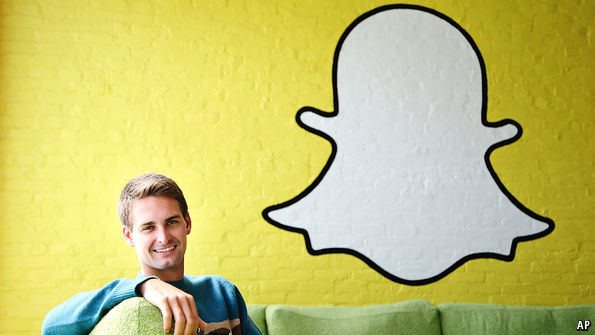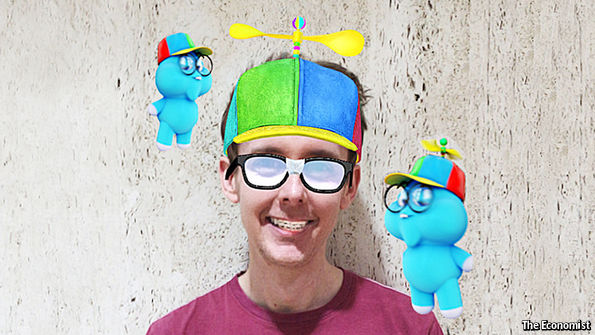Winner takes all: A slow-motion revolution
Traditional TV’s surprising staying power
from The Economist

You have to wait until a certain hour on a certain day on a certain channel to watch TV. TV is terrifyingly antiquated
People will be able to pick any show at any time from just a few favourite platforms like Netflix or Amazon as well as Facebook and Snapchat
But all this is happening in slow motion, because both distributors and networks have a deeply vested interest in retaining it
Broadcast television is being eroded: 1) billions of people are now watching free videos on SNS supported by targeted advertising
2) Subscription services are amassing big user bases with a low subscription & investing heavily in content, which is strangling a cable TV
In the late C20, the number of channels of cable TV increased as media companies discovered serving niche audiences could generate revenues
Yet as media companies kept adding channels, pay TV hit the limit of the number of channels an average consumer can see in a week: 17
In US the typical pay-TV bill has doubled in a decade, to more than $100 a month, which created an opportunity for internet video providers
US’s viewing of broadcast & cable TV by all age groups fell by 11% & aged 12-24 40% in past 6 yrs. The market penetration: 90% (2010) to 80%
Cord-cutting is beginning in developed markets like US and will damage the cabe TV companies enjoying gross profit margins of 30-60%
Somewhat ironically, TV is now at it’s best because networks (e.g. HBO and FX) and streaming services are competing for subscribers
This competition has given viewers shows that cost $10m an episode and has caused Netflix to pay huge for a third season of Black Mirror
Not everyone will be a winner. Last year 450 original shows were available on US’s TV, more than twice as many as 6 yrs earlier
The $109bn acquisition of Tme Warner would give AT&T vertical integration to protect it if and when the current pay-TV system crumbles
Sports programmes, the last stronghold of the pay-TV oligopoly, accounted for 93 of the 100 broadcasts in 2015, compared with 14 in 2005
Advertising rates in general have been flat or declining in most of the industry, but spending on ads for sports has risen by 50% 2005-2015
The cost of sports rights has been rising. Annually, ESPN is paying $5.5bnr for NFL. ESPN and TNT are paying $24bn for NBA
Investors are asking how long this can go on. ESPN lost millions of subscribers in recent years. The escalating fees will put them off more
For mobile devices streaming rights are sold separately. Telecom companies are likely to offer increasingly large fees to stream sports
The existing business model remains too lucrative to abandon. But eventually fans will watch sports on screens in alternative realities.
| 2017/02/25
| Business, Summary
|
Reproductive technologies
Gene editing, clones and the science of making babies
from The Economist

20 yrs ago, Dolly the sheep triggered much fuss about nothing. Now, technological advances are making cloning humans more feasible
Some fear of people’s control over reproduction. Others argue for the right to alleviate suffering from childlessness or genetic diseases
Last year, new reproductive practice was added: mitochondrial transplantation / three-parent children
They bring the possibility of choosing which embryo will live or die, which can seem disgusting. But disgust is not a good guide to policy
Disgust often goes along with dystopian alarm. Reproductive science’s progress is so fast that people worry about the outcome
Mitochondrial transplants are intended to avoid dangerous diseases and will be familiar like other reproductive practices e.g. IVF and AID
Researchers should not be allowed to experiment on human fetuses, test within the law’s bounds and value people’s happiness and health
Growing sperm and eggs from body cells allows gay couples to have children but should be banned for one parent because of the child’s health
Gene editing will eliminate genetic diseases. But breeding babies with new traits and cloning other people raises questions
Should bereaved parents be able to clone a lost child? Should the wealthy be able to pay for their children to be intelligent and diligent?
Opinions change as people get used to. We need to protect the interests of the unborn. The risk is to hold back and leave people to suffer
| 2017/02/21
| Science & Technology, Summary
|
Reality, only better
The promise of augmented reality
from The Economist

SF predicts the future and influences the technologists. Mobile phones are real-life versions of the hand-held communicators in “Star Trek”
If companies like Microsoft, Google, Magic Leap and Meta have their way, the next thing to leap from fiction to fact will be AR
AR will take three-quarters of the $108 billion a year which Digi-Capital predicts will be spent by 2021 on VR and AR combined
Now, as computers have shrunk and become powerful enough, it has become possible to give people the same experience as their daily lives
Last year, the world was briefly entranced by an AR smartphone game called Pokémon Go. Apps such as Snapchat are another example.
Google’s Translate app employs automatic translation and a smartphone’s camera to show an image with text interpreted into other languages
Snapchat and Translate rely on machine-vision algorithms. Snapchat is designed to detect faces. Translate looks for text in the world
Google and Lenovo unveiled a Tango-enabled phone which can model a house, an office or any other space upon which it can draw things
An app for Tango, “Measure”, overlays a virtual tape measure on a phone’s screen. “Woorld” lets users fill their rooms with virtual objects
Tango is impressive but is still in its early stages. AR may not take off until smartphones can be abandoned in favour of smart spectacles
Such glasses do exist. So far, though, they have made a bigger impact on the workplace than in the home
Boeing is using AR glasses to give workers in its factories step-by-step instructions. The result is faster work with fewer mistakes
Google’s “Glass” did not go well. The idea of it was to create a wearable smartphone, all the while leaving his hands free for other tasks
Google stopped making Glass in 2015 on privacy grounds, although it is working on a new version aimed at businesses instead of individuals.
RideOn, an Israeli company, will start selling AR ski goggles which turn skiing into a video game by showing users routes
Unlike Google’s Glass, Microsoft’s HoloLens can draw 3D images that appear to exist in the real world
It is like a Tango-enabled smartphone whose cameras scan the world around it and generate such a flood of information
Unlike VR headsets, HoloLens is a self-contained computer that needs no accessories
By overlaying its images onto the real world, the HoloLens headset turns reality into a computer monitor
The first demonstrations of the HoloLens involved games. More recent apps have focused on business and training like an anatomy practice
HoloLens can be used collaboratively, as well. A guide can see what the HoloLens user sees and put circles around objects of interest
Aecom is already using the HoloLens to help design very complicated modern buildings
In 2016 Aecom designed buildings with complex roofs which they couldn’t check on a 2D screen. But HoloLens let them all review it together
The HoloLens is far from perfect. It is bulky, unfashionable and expensive. The view is too small, and the gesture-tracking system is clunky
One rival of Microsoft is Meta whose AR headsets will have a much wider field of view and recognize more hand gestures than HoloLens
Magic Leap has attracted $1.4 billion in investment from Google and Ali Baba. The demos it has released show images clearer than HoloLens
AR is still at an early stage, especially as a consumer technology. Market forecasts of AR might be too exaggerated as well as ones of VR
Even among techies, enthusiasm for VR seems limited. A survey by Steam found that just 0.38% of its customers owned a VR headset in December
Consumer versions of AR should be adapted for peoples’ phones. But a phone’s screen is small, fiddly and tedious to use for AR apps
Mark Zuckerberg thinks VR and AR headsets will be like normal-looking glasses. Samsung and Apple are exploring the idea of AR contact lenses
None of the present approaches to AR seems to change the world as iPhone did. But those behind them hope that a combination of them will
| 2017/02/12
| Science & Technology, Summary
|
The anti-Facebook
Snap’s IPO will be the largest in years
from The Economist

When Snap goes public at an expected valuation of $20bn-25bn its market debut will be the most closely watched since Alibaba floated in 2014
Around 41% of Americans aged 18 to 34 use Snapchat every day, and 150m people globally spend time on it every day
Snapchat is experimenting with new technologies. A large share of people who have used AR will have experienced it on Snapchat
The firm’s IPO prospectus is expected to describe a “camera company”. Its new sunglasses, Spectacles, have caught the attention of analysts
Facebook’s users post permanent records of their lives to a huge circle; Snapchat’s users share impermanent silly images with smaller groups
Snapchat was launched by three students at Stanford University in 2011. It lay undiscovered until high-school girls started using it
Mr Spiegel is good at devising and evolve Snapchat’s features which offer elements of scarcity and urgency that bring people back repeatedly
Snapchat shows users how many snaps they have sent and received since joining, and they try to keep this score high
“Lenses” alters the appearance of users using facial-recognition technology. Snapchat has quietly become the most-used AR product
Snap may need to share more data about its users to target ads. Mr Spiegel has indicated that he may be willing to do this
Snap has started to allow advertising in their apps. It insists on keeping creative control and can veto ads look too much
Though Snapchat’s revenue is far below of Google and Facebook, advertisers certainly welcome an alternative to the Facebook-Google duopoly

Yet there are questions over the high stockmarket valuation. The app has yet to establish strong appeal for older users and emerging markets
Snap is expected to point to high user engagement in Western markets with Snapchat rather than global user growth like Facebook and Twitter
Snap’s profit margins may also disappoint because its ads are not automated like Google but tend to rely on a large human salesforce
Mr Spiegel is secretive like Steve Jobs. No one but Mr Spiegel knows all the important details of the firm’s strategy and future plans
Some early backers also privately express concern that the talent pool behind him is not as experienced as they would like
Last summer Instagram owned by Facebook launched its own “stories” feature. Usage of Snapchat stories has declined significantly since then
The public offering stands as evidence that Snap wants to stay independent. But Mr Spiegel must know Facebook and Google could still buy it
If Snap wants to survive as an independent firm, he may need to make some smart acquisitions by buying, say, a visual search firm
| 2017/02/11
| Business, Summary
|
Augmented reality
Why augmented reality will be big in business first
from The Economist

THE history of computers is one of increasing intimacy from mainframe machines to smartphones
The next step is to build a pair of “smart glasses”. AR could bring about a new and more intimate way to interact with machines
For the time being, the most popular AR apps are still found on smartphones. Pokémon Go and Snapchat are using the technology
Microsoft is already running trials of its HoloLens headset in medical schools and architectural practices
AR’s the first problem is aesthetic. The HoloLens’ alien appearance makes its wearers look more creepy than cool
The other problem is consent. In 2013 Google launched its “Glass” headsets. But plenty were worrying that users were covertly filming
Both of these problems are solvable. It may well be possible to build a pair of fashionable AR glasses. Social etiquette also evolves
AR seems likely to follow the same path to popularity as smartphones. The first mobile phones were brick-sized and a target of mockery
| 2017/02/10
| Science & Technology, Summary
|






